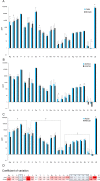Use of handheld X-ray fluorescence as a non-invasive method to distinguish between Asian and African elephant tusks
- PMID: 27097717
- PMCID: PMC4838944
- DOI: 10.1038/srep24845
Use of handheld X-ray fluorescence as a non-invasive method to distinguish between Asian and African elephant tusks
Abstract
We describe the use of handheld X-ray fluorescence, for elephant tusk species identification. Asian (n = 72) and African (n = 85) elephant tusks were scanned and we utilized the species differences in elemental composition to develop a functional model differentiating between species with high precision. Spatially, the majority of measured elements (n = 26) exhibited a homogeneous distribution in cross-section, but a more heterologous pattern in the longitudinal direction. Twenty-one of twenty four elements differed between Asian and African samples. Data were subjected to hierarchical cluster analysis followed by a stepwise discriminant analysis, which identified elements for the functional equation. The best equation consisted of ratios of Si, S, Cl, Ti, Mn, Ag, Sb and W, with Zr as the denominator. Next, Bayesian binary regression model analysis was conducted to predict the probability that a tusk would be of African origin. A cut-off value was established to improve discrimination. This Bayesian hybrid classification model was then validated by scanning an additional 30 Asian and 41 African tusks, which showed high accuracy (94%) and precision (95%) rates. We conclude that handheld XRF is an accurate, non-invasive method to discriminate origin of elephant tusks provides rapid results applicable to use in the field.
Figures






Similar articles
-
Elemental classification of the tusks of dugong (Dugong dugong) by HH-XRF analysis and comparison with other species.Sci Rep. 2017 Apr 7;7:46167. doi: 10.1038/srep46167. Sci Rep. 2017. PMID: 28387333 Free PMC article.
-
Distinguishing real from fake ivory products by elemental analyses: A Bayesian hybrid classification method.Forensic Sci Int. 2017 Mar;272:142-149. doi: 10.1016/j.forsciint.2017.01.016. Epub 2017 Jan 21. Forensic Sci Int. 2017. PMID: 28157639
-
Elemental Analysis of Asian Elephant (Elephas maximus) Teeth Using X-ray Fluorescence and a Comparison to Other Species.Biol Trace Elem Res. 2016 Mar;170(1):94-105. doi: 10.1007/s12011-015-0445-x. Epub 2015 Jul 22. Biol Trace Elem Res. 2016. PMID: 26194819
-
Genomic inferences from Afrotheria and the evolution of elephants.Curr Opin Genet Dev. 2005 Dec;15(6):652-9. doi: 10.1016/j.gde.2005.09.014. Epub 2005 Oct 13. Curr Opin Genet Dev. 2005. PMID: 16226885 Review.
-
Ivory Harvesting Pressure on the Genome of the African Elephant: A Phenotypic Shift to Tusklessness.Head Neck Pathol. 2016 Sep;10(3):332-5. doi: 10.1007/s12105-016-0704-y. Epub 2016 Feb 26. Head Neck Pathol. 2016. PMID: 26920555 Free PMC article. Review.
Cited by
-
Morphometric, histometric and elemental profile of the metacarpal and metatarsal bones in adult Sanjabi sheep.Vet Res Forum. 2025;16(5):293-300. doi: 10.30466/vrf.2024.2034586.4349. Epub 2025 May 5. Vet Res Forum. 2025. PMID: 40693025 Free PMC article.
-
Elemental classification of the tusks of dugong (Dugong dugong) by HH-XRF analysis and comparison with other species.Sci Rep. 2017 Apr 7;7:46167. doi: 10.1038/srep46167. Sci Rep. 2017. PMID: 28387333 Free PMC article.
-
Discrimination of highly degraded, aged Asian and African elephant ivory using denaturing gradient gel electrophoresis (DGGE).Int J Legal Med. 2021 Jan;135(1):107-115. doi: 10.1007/s00414-020-02414-w. Epub 2020 Sep 25. Int J Legal Med. 2021. PMID: 32975592
-
Determining the Provenance of Traded Wildlife in the Philippines.Animals (Basel). 2023 Jun 30;13(13):2165. doi: 10.3390/ani13132165. Animals (Basel). 2023. PMID: 37443963 Free PMC article.
-
Elemental Analysis of Bone, Teeth, Horn and Antler in Different Animal Species Using Non-Invasive Handheld X-Ray Fluorescence.PLoS One. 2016 May 19;11(5):e0155458. doi: 10.1371/journal.pone.0155458. eCollection 2016. PLoS One. 2016. PMID: 27196603 Free PMC article.
References
-
- Lemieux A. M. & Clarke R. V. The international ban on ivory sales and its effects on elephant poaching in Africa. Br J Criminol 49, 451–471 (2009).
Publication types
MeSH terms
LinkOut - more resources
Full Text Sources
Other Literature Sources
Medical

